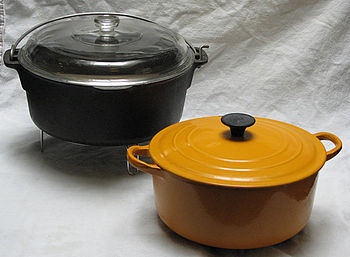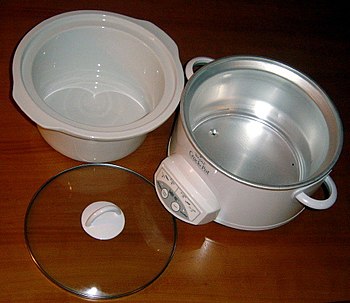The crock pot, which was very popular in the 1970s, has enjoyed a rediscovery of sorts. The convenience, energy savings, and time savings of the crock pot has attracted a whole new fan. The 'set it and forget it' group is back! And, with the new and improved crock pot designs, efficiency and ease of use is a big seller.
| Dutch ovens. (Photo credit: Wikipedia) |
So, how do we decide which method is best for making one pot meals? Let's take a look at a few reasons you might choose one or the other, or both.
Heat
Browning meat before adding it to a dish is usually a good idea. This method adds not only color and flavor, but sears the meat to seal the juices. It also provides those nice 'browned bits' on the bottom of the pot that recipes often call for deglazing with a liquid. This flavor cannot be ignored.
A crock pot is not designed to get hot enough on the bottom to sear protein. You won't get 'browned bits' and you won't be able to create a roux with flour and butter effectively in a crock pot.
You will also not be able to saute onion, celery, or garlic before adding the remaining ingredients in a crock pot. Again, the temperature on the bottom of the crock pot simply will not work well. You can try to turn the crock pot to high and add the ingredients, but the results will not be the same as cooking on a stovetop.
To solve this, you can brown the meat and saute the vegetables in a separate skillet over high heat, then add the ingredients to the crock pot. You could then deglaze the skillet to get up the 'browned bits' and add them to the crock pot. This works, but it does require more steps and more clean up.
The Dutch oven wins this argument. Browning and sauteing, when desired, is best done in the same Dutch oven you are using for your meal preparation, both for flavor and for clean up.
Ease
You can't argue the fact that putting ingredients in the crock pot, setting it and forgetting it, has its advantages. If your home life is chaotic after school and after work, walking into the house and having a crock pot meal all ready to eat is a plus.
Recipes for crock pot meals that take eight, nine, or ten hours are never difficult to find, meaning even if you are away from home for that long, you can still come home to a delicious meal in the crock pot.
Meals can even be prepared the night before, with veggies, meat, and liquid all layered in the crock pot insert and put in the refrigerator. Then, in the morning, just put the insert in, plug it in, and turn the heat to low.
Some crock pots have more sophisticated timers that you can set to turn on when you want and even lower the temperature to keep it warm until you get home.
The crock pot wins this argument. Nothing beats the ease of having everything together and just setting a timer to start when you leave, and be ready when you get home. If you don't do any browning in a separate pan, clean up is easy, too.
Simmering
When you put a Dutch oven on top of a burner on low, you have one disadvantage over a crock pot; the heat source is direct. You will have to check and stir the contents often. If the burner is set low enough to keep the contents from sticking or burning on the bottom, you may not get enough heat to keep the rest of the contents simmering.
| The major parts of a crock-pot, namely the heating component, the ceramic pot and a glass lid. (Photo credit: Wikipedia) |
Of course, many of the newer, heavier Dutch ovens are made so well that the heat is distributed evenly around the entire bottom and up the sides. And, many crock pots now come with a wide range of temperature settings to help maintain a slow simmer.
There is a lot to consider here. Basically, neither the Dutch oven nor the crock pot is the clear winner in this argument. The Dutch oven must be watched and adjusted, while the crock pot has a more even simmer, but it could be too fast with no adjustment available. This is strictly a personal preference, and depends on the equipment you have and the meals you are making.
Conclusion
The simple fact is, there are pros and cons to both the Dutch oven and the crock pot. Searing and browning is important for many dishes, so you may want to cook in a Dutch oven to keep everything in one pot. Or, your lifestyle may require meals ready the moment you walk in the door, which would best be served with a crock pot for easiest preparation and clean up.
In my opinion, you need both. If the cost and storage space works, invest in a good Dutch oven
And be sure to check back here throughout this month for some simple and tasty one-pot recipes!



No comments:
Post a Comment
We welcome comments and suggestions!